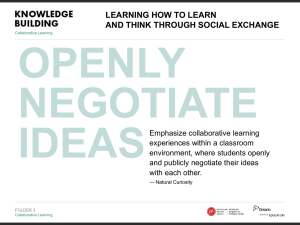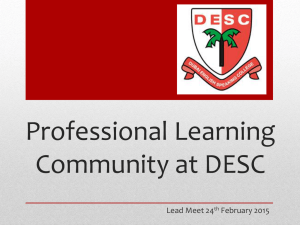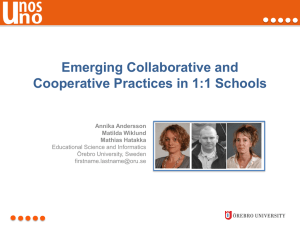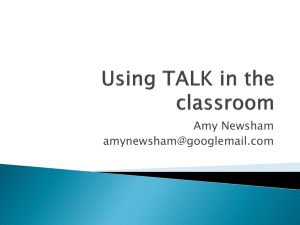Using collaborative learning techniques
advertisement
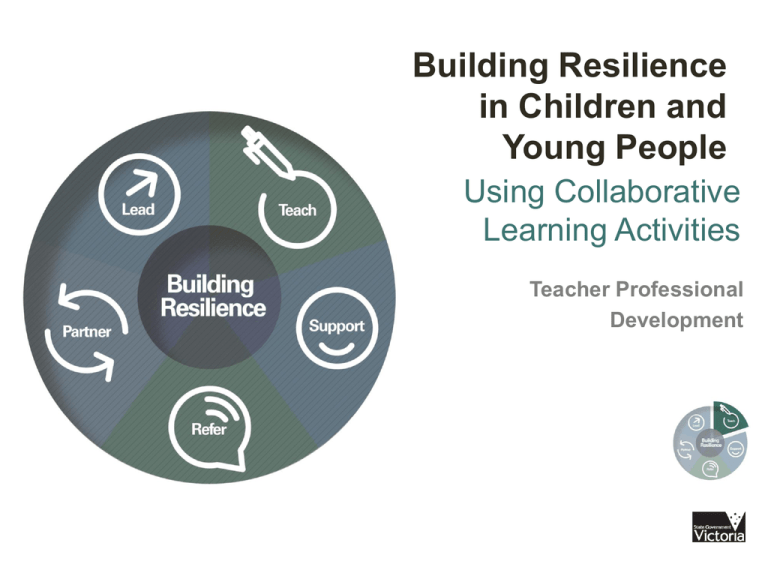
Building Resilience in Children and Young People Using Collaborative Learning Activities Teacher Professional Development Using Collaborative Learning Activities What are Collaborative Learning Strategies? ‘Collaborative learning strategies’ are dialogic in nature and involve student-to-student interaction, rather than just teacher-student interaction Include activities such as: • role-play and simulation • small group problem-solving discussions • critical-thinking tasks • skills development exercises • themed games Such strategies are central to SEL, life-skills, sexuality and drug education programs (Cahill 2006) Using Collaborative Learning Activities Collaborative learning strategies are central to effective SEL programs • Collaborative learning strategies help students to build skills (rather than just learn new knowledge) • Collaborative learning strategies help students to think about the challenges that they may encounter in their lives Good SEL programs give students an opportunity to learn and apply their skills and to rehearse for future situations Using Collaborative Learning Activities Teacher use of collaborative learning strategies • Collaborative learning tasks require a high level of facilitation from the teacher as they must organise and moderate students’ interactions both with peers and with the task • The teacher is a significant element and variable in the delivery of a program • When the collaborative learning tasks are not used, the SEL program does not deliver the same outcomes • The most successful program have provided teachers with training in how to deliver the SEL learning activities Natvig et al. 2003 Using Collaborative Learning Activities Building teacher confidence in using collaborative learning strategies • Some teachers and students who are less accustomed to working via collaborative learning tasks may wish to spend additional time setting up group agreements and norms, and provide some explicit coaching on the use of team skills in group work • The introductory lessons provided in the secondary materials can be used to build a positive group atmosphere and establish some group agreements with new classes. They could also be adapted for use in the primary classroom though most teachers will have already set up classroom rules and expectations • The games provided in each topic can be used to help the class learn to mix well with each other and to develop social good will whilst also developing SEL skills Promoting Positive Relationships Group Activity: Qualities that I admire 1. Allocate each pair a scenario 2. Ask them to: restate the problem in their own words, choose who this person could ask for help, work out what they could say to the person they approach for help, and work out what they could do or say if the person being asked for help was too busy or was not helpful 3. Ask participants to design and prepare two short role-plays, one in which they show a good response from the help-giver and one in which they show a poor response from the help-giver 4. Arrange for participants to show their role-plays. Ask them to note what the player has done well in asking for help. Also ask: what does it take to ask for help? Example scenario 1 : You’ve been away sick and don’t know how to do the assignment. Who will you ask for help? What could you say? Example scenario 2: You don’t know how to use the new reporting system. Who will you ask for help? What could you say? This activity is adapted from the Level 3-4 Building Resilience learning materials (Topic 6: Help-seeking, Activity 2) Using Collaborative Learning Activities Individual Activity: Help-seeking scenarios (Adapted from Level 3-4) Choose one of the scenarios below and answer the questions: • What could he or she do? • Who could he or she ask to help? • What could friends do to help? Gina finds that her mobile phone has been stolen from her handbag while everyone was in class Tim’s little brother is being bullied at school, and now while they are walking to school, he has started crying because he is scared it will happen again This activity is adapted from the Level 3-4 Building Resilience learning materials (Topic 6: Helpseeking, Activity 2) Using Collaborative Learning Activities Participatory Pedagogy Participatory learning strategies are integral to the effectiveness of health education programs Herbert, P. C., & Lohrmann, D. K.(2011) Participatory learning strategies are the exception rather than the norm in within general teaching practice Natvig, G. K., Albrektsen, G., & Qvarnstrom, U. (2003). When the participatory learning tasks are not used, the program does not deliver the same outcomes Stead, M., Stradling, R., Macneil, M., Mackintosh, A. M., & Minty, S. (2007). Using Collaborative Learning Activities Participatory method works even when not addressing specific health content • Use of participatory learning strategies is not the norm for most teachers • In this study only 15% of the pupils reported that they were often/very often engaged in small group tasks • Those students who got to do participatory work: built connectedness to school, exercised their social skills developed greater levels of confidence that their teachers and their peers can be a source of help when they experience violence or distress Natvig, G. K., Albrektsen, G., & Qvarnstrom, U. (2003) Using Collaborative Learning Activities Play and SEL learning • Young children develop SEL skills through their free play with peers • Play can provide a medium for becoming more self-aware, empathic and motivated as well as becoming more able to manage feelings and develop and deploy social skills Woolf A. (2013) Using Collaborative Learning Activities Games for SEL • Collaborative games are a powerful way of developing social and emotional learning in young people • The social and emotional skills needed to play successfully with others are those needed to succeed at work and in adult life • Pro-social skills involve regulating negative emotions, taking turns and sharing, support orientations to others that are fair, just, and respectful Hromek, R., & Roffey, S. (2009) Using Collaborative Learning Activities Circle Time • Can provide a space for students to talk together about important issues, and to think creatively and reflectively • Circle time can be used as a time for group discussion, co-operative team games, songs, stories and relaxation • Many of the early primary activities have a ‘circle time’ component Using Collaborative Learning Activities Circle Time (continued) Key principles of circle time: • Respect: rules emphasise respect for individuals and their contribution • Democracy: equal opportunity for all to participate • Community: promotes a whole class ethos where everyone is responsible for each other • Inclusion: everyone is welcome • Choice: no one is pressured to participate • Agency: rather than telling students what to do, provides a framework for students to take responsibility • Reflection: games and activities designed to encourage reflection • Creativity: wide scope for creativity • Positive emotionality: activities structured to facilitate positive emotions in students • Fun: Focus is on feeling good, safe and supported, increasing a sense of belonging Roffey, 2006 Using Collaborative Learning Activities Sample positive sharing ideas from Foundation and Level 1-2 Brief examples from the lessons: • At Foundation level: ‘Arrange for students to share their pictures in circle time. Ask those who felt they learnt more about each other from the activity to put their hands up. Remind them that learning about how others feel is a good friendship skill.’ • At Level 1 /2: ‘Arrange for students to post their letters in the classroom post-box to be read at circle time over the following days or weeks.’ Using Collaborative Learning Activities Group Activity:The Connections Game – a focus on partnership skills (Adapted from Level 1-2 SEL materials) 1. Find a partner 2. Work together to keep a chopstick ‘held’ between your index fingers (each person in the pair should have their index finger in contact with one of the two tips of the chopstick, so that the chopstick is horizontal to the ground) 3. Move around the room, experimenting with turns and moving up and down, without dropping the chopstick 4. Gradually, other chopsticks will be added to the game to link pairs together with other pairs, until the whole group is in a single chopstick line moving around the room This game highlights the importance of team work and building connections Using Collaborative Learning Activities Group Activity: The Knots problem-solving game (Adapted from Level 3-4) • Form groups of 8 • Close your eyes, put your hands forward, and grip another person’s hand in each of yours • You will now form a giant human knot. The group must find a way of undoing the knot, without letting go of each other’s hands, and without hurting anyone Using Collaborative Learning Activities REFLECT • How and when do you use collaborative learning strategies in your regular teaching? • What opportunities do you see to use collaborative learning to improve engagement, thinking and social development? Using Collaborative Learning Techniques References • • • • • • • Cahill, H. (2006). Devising Classroom Drug Education Programs. In R. Midford & G. Munro (Eds.), Drug Education in Schools: Searching for the Silver Bullet (pp. 147-165). Camberwell: Pearson. Herbert, P. C., & Lohrmann, D. K. (2011). It's All in the Delivery! An Analysis of Instructional Strategies From Effective Health Education Curricula. Journal of School Health, 81(5), 258-264. Hromek, R., & Roffey, S. (2009). Promoting Social and Emotional Learning With Games: ''It's Fun and We Learn Things''. Simulation & Gaming, 40, 626-644. Natvig, Gerd Karin, Albrektsen, Grethe, & Qvarnstrom, Ulla. (2003). Methods of Teaching and Class Participation in Relation to Perceived Social Support and Stress: Modifiable Factors for Improving Health and Wellbeing among Students. Educational Psychology: An International Journal of Experimental Educational Psychology, 23(3), 261-274. Roffey, S. (2006) Circle Time for Emotional Literacy, London, SAGE Publications Inc. Stead, M., Stradling, R., Macneil, M., Mackintosh, A. M., & Minty, S. (2007). Implementation evaluation of the Blueprint multi-component drug prevention programme: fidelity of school component delivery. [Article]. Drug & Alcohol Review, 26(6), 653-664. Woolf A. Social and Emotional Aspects of Learning: teaching and learning or playing and becoming?. Pastoral Care In Education [serial online]. March 2013;31(1):28-42. Available from: Academic Search Complete, Ipswich, MA. Accessed August 9, 2013.

